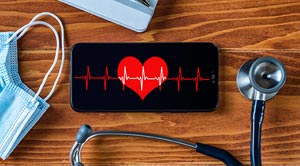Oneida Health
What is Holter or Event Monitoring
 A Holter monitor is a device that continuously records the heart’s rhythms. The monitor is typically worn for approximately 24, 48 or 72 hours during normal activity. An event monitor does not record continually. It begins recording when it is activated. Some event monitors begin recording automatically when they detect abnormal heart activity.
A Holter monitor is a device that continuously records the heart’s rhythms. The monitor is typically worn for approximately 24, 48 or 72 hours during normal activity. An event monitor does not record continually. It begins recording when it is activated. Some event monitors begin recording automatically when they detect abnormal heart activity.
How the Test is Performed
Electrodes are stuck onto your chest and attached to a small recording monitor. You carry the Holter monitor at your waist with a clip. The monitor is battery operated. While you wear the monitor, it will record your heart’s electrical activity. Keep a diary of what activities you do while wearing the monitor, and how you feel.
Why the Test is Performed
Holter monitoring is used to determine how the heart responds to normal activity. The monitor may also be used:
- After a heart attack or stroke
- To diagnose heart rhythm problems
- When starting a new heart medicine
- It may be used to diagnose:
- Atrial fibrillation or flutter
- Multifocal atrial tachycardia
- Palpitations
- Paroxysmal supraventricular tachycardia
- Reasons for fainting
- Slow heart rate (bradycardia)
- Ventricular tachycardia
How to Prepare for the Test
There is no special preparation for the test. The monitor will be started for you and you will be told how to replace the electrodes should they fall off or become loose. Tell the technician if you are allergic to any tape or other adhesives. Shower or bathe prior to starting the test as you will not be able to do so while wearing the monitor.
What to Expect During the Test
This is a painless test. Some people may need to have their chest shaved so the electrodes can stick. You must keep the monitor close to your body, which may make it hard for you to sleep.
While wearing the device, avoid electric blankets, high-voltage areas, magnets, and metal detectors,
No showering, bathing, or swimming while wearing the monitor.
You will wear the monitor during normal activities. Make a note of what you are doing if you feel any of the following symptoms:
- Any fluttering or skipped heartbeats
- Lightheadedness
- Chest pain
- Shortness of breath
You may be asked to exercise while being monitored if your symptoms have occurred in the past while you were exercising.
After your monitoring period you will return to your doctor’s office to return the monitor and for your doctor to review the results.
What the Test Results Show
Your doctor will review the results from the monitor and be able to tell if you have a heart condition or if your current heart medication is working or is not working. If you did not have any heart irregularities while wearing the monitor, your doctor may order additional tests.
Potential Risks of the Test
This is a painless test with minimal risks. You may experience some irritation at the site where the electrodes adhered to your skin.
You must avoid the following items while you are wearing your monitor:
- Electric blankets
- Electric razors and toothbrushes
- Magnets
- Metal detectors
- Microwave ovens
You must also keep cell phones and other devices at least 6 inches away from the monitor at all times.